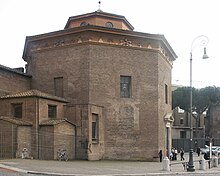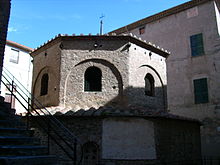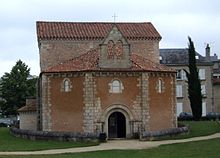Baptistery

InChristian architecturethebaptisteryorbaptistry(Old Frenchbaptisterie;Latinbaptisterium;Greekβαπτιστήριον,'bathing-place, baptistery', fromβαπτίζειν,baptízein, 'to baptize') is the separate centrally planned structure surrounding thebaptismal font.The baptistery may be incorporated within the body of a church orcathedral,and provided with an altar as a chapel. In the earlyChurch,thecatechumenswere instructed and thesacramentofbaptismwas administered in the baptistery.
Design
[edit]
The sacramental importance and sometimes architectural splendour of the baptistery reflect the historical importance ofbaptismto Christians. Beginning in the fourth century, baptisteries in Italy were often designed with an octagonal plan.[1]The octagonal plan of theLateran Baptistery,the first structure expressly built as a baptistery, provided a widely followed model. The baptistery might be twelve-sided, or even circular as atPisa.[2]
In anarthexoranteroom,the catechumens were instructed and made theirconfession of faithbefore baptism. The main interior space centered upon thebaptismal font(piscina), in which those to be baptized were thrice immersed. Three steps led down to the floor of the font, and over it might be suspended a gold or silver dove. The iconography offrescosormosaicson the walls were commonly of the scenes in the life ofSaint John the Baptist.The font was at first always of stone, but latterly metals were often used.
The Lateran baptistery's font was fed by a natural spring. When the site had been the palatial dwelling of the Laterani, before Constantine presented it to Bishop Miltiades, the spring formed the water source for the numerous occupants of thedomus.As the requirements for Christian baptisteries expanded,Christianization of sacred pagan springspresented natural opportunities.Cassiodorus,in a letter written in AD 527, described a fair held at a former pagan shrine ofLeucothea,in the still culturally Greek region of southern Italy. This shrine had been Christianized by converting it to a baptistery (Variae8.33). There are also examples of the transition from miraculous springs to baptisteries fromGregory of Tours(diedc.594) andMaximus, bishop of Turin(diedc.466).[3]
History
[edit]
Baptisteries belong to a period of the church when great numbers of adult catechumens were baptized andimmersionwas the rule. They did not seem to be common before the emperors Gratian, Valentinian, and Theodosius madeChristianitythestate religionin theEdict of Thessalonica(i.e. before the 4th century). As early as the 6th century, the baptismal font was commonly built in theporchof the church, before it was moved into the church itself. After the 9th century, with infant baptism increasingly the rule, few baptisteries were built. Some of the older baptisteries were so large that there are accounts of councils andsynodsbeing held in them. They had to be large because a bishop in the early church would customarily baptize all the catechumens in hisdioceseand the rite was performed only three times a year, on certain holy days. Baptisteries were thus attached to thecathedraland not to theparishchurches. In the Italian countryside apievewas a church with a baptistery on which other churches without baptisteries depended.
During the months when no baptisms occurred, the baptistery doors were sealed with thebishop'sseal,a method of controlling the orthodoxy of all baptism in the diocese. Some baptisteries were divided into two parts to separate the sexes;[4]or sometimes the church had two baptisteries, one for each sex. Afireplacewas often provided to warm the neophytes after immersion.

Though baptisteries were forbidden to be used as burial-places by theCouncil of Auxerre(578), they were sometimes used as such. The FlorentineAntipope John XXIII(d. 1419) was buried in theFlorence Baptistery,facingFlorence Cathedral,with great ceremony, and a large and sculpturally importanttomb by Donatello and his partner.Many of the earlyarchbishops of Canterburyin England were buried in the baptistery at Canterbury.
According to the records of early church councils, baptisteries were first built and used to correct what were considered the evils arising from the practice of private baptism. As soon as Christianity had expanded so that baptism became the rule, and as immersion of adults gave place to sprinkling of infants, the ancient baptisteries were no longer necessary. They are still in general use, however, in Florence and Pisa.

TheLateran Baptisterymust be the earliest ecclesiastical building still in use. A large part of it remains as built byConstantine.The central area, with the basin of the font, is an octagon around which stand eightporphyrycolumns, withmarblecapitals andentablatureof classical form. Outside these are anambulatoryand outer walls forming a larger octagon. Attached to one side, toward the Lateran basilica, is a porch with two noble porphyry columns and richly carved capitals, bases and entablatures.
The circular church ofSanta Costanza,also of the 4th century, served as a baptistery and contained the tomb of the daughter of Constantine. This is a remarkably perfect structure with a central dome, columns, and mosaics of classical fashion. Two side niches contain the earliest known mosaics of distinctively Christian subjects. In one is representedMosesreceiving the Old Law, in the otherChristdelivers toSaint Peterthe New Law charter, sealed with the XP monogram.[5]
The earliest surviving structure that was used as a baptistery is the tomb-like baptistery atDura-Europas.[6]Another baptistery of the earliest times has been excavated atAquileia.Ruins of baptisteries have also been found atSalonaand inCrete.[7]AtRavennaare two noted baptisteries, decorated with finemosaics.One was built in the mid-5th century, and the other in the 6th. A large baptistery decorated with mosaics was built in the 6th century atNaples.[5]
In the East, the metropolitan baptistery at Constantinople still stands at the side of the former patriarchalChurch of Holy Wisdom.Many others, inSyriafor example, were found in late 19th and early 20th-century archaeological research, as were some belonging to churches ofNorth Africa.InFrancethe most famous early baptistery isBaptistère Saint-JeanatPoitiers.Other early examples exist atRiez,FréjusandAix-en-Provence.InEngland,a detached baptistery is known to have been associated withCanterbury Cathedral.[5]
Revival in medieval Italy
[edit]
In most of Europe the early Christian practice of having a distinct baptistery building, useful when large numbers of adultcatechumenswere being instructed and then baptised in groups by immersion, had lapsed by the Late Middle Ages, when baptisms werenormally of infants,and used sprinkling with holy water rather than immersion. Instead, smaller fonts were placed inside the church. But in north Italy separate baptisteries revived, probably largely as an expression of civic pride, placed beside the cathedral, and often with a separatecampanileor bell-tower.[8]
Among the more spectacular Romanesque and Gothic examples, theFlorence Baptisterywas built between 1059 and 1128, thePisa Baptisterybegun 1152 (replacing an older one) and completed in 1363, theParma Baptisterywas begun in 1196,Pistoiain 1303; all these have octagonal exteriors.[9]TheSiena Baptisterywas begun in 1316, then left incomplete some decades later.[10]
Famous baptisteries
[edit]Famous Italian baptisteries include:
- Lateran Baptistery,Rome, the most significant and architecturally most influential baptistery in the Christian West, founded byPope Sixtus III
- Parma Baptistery
- Florence Baptistery,TuscanRomanesque-style structure associated withFlorence Cathedral,rebuilt between 1059 and 1150; it containsGhiberti'sDoors of Paradise
- Pisa Baptistery,circular domed Baptistery of St John clad in white marble in thePiazza del Duomo,Pisa,built in stages from 1152 and combining Romanesque withGothic.
- Lomello Baptistery of San Giovanni ad Fontes

Famous French baptisteries include:
- Baptistery ofFréjus Cathedral
- Baptistery ofAix Cathedralin Aix-en-Provence
- BaptisteryofPoitiers,reputedly the oldest Christian building in France.[11]

Byzantine baptisteries of the Holy Land: Emmaus Nicopolis
See also
[edit]Notes
[edit]- ^Jensen, Robin M. (2012-06-01).Baptismal Imagery in Early Christianity: Ritual, Visual, and Theological Dimensions.Grand Rapids, MI: Baker Academic. p. 208.ISBN978-1-4412-3627-2.
- ^Brandt, Olof (2006). "The Lateran Baptistery and the diffusion of octagonal baptisteries from Rome to Constantinople". In Reinhardt Harreither (ed.).Frühes Christentum zwischen Rom und Konstantinopel: Acta Congressus Internationalis XIV Archaeologiae Christianae, Vindobonae 19.-26. 9. 1999.Studi di antichità cristiana 62, Archäologische Forschungen. Vatican City: Pontificio Istituto di Archeologia Cristiana. pp. 221–227.ISBN9788885991422.
- ^Barnish, S.J.B. (2001). "Religio in stagno: Divinity, and the Christianization of the Countryside in Late Antique Italy".Journal of Early Christian Studies.9(3): 387–402.doi:10.1353/earl.2001.0037.ISSN1086-3184.S2CID171024168.
- ^Augusti; Coleman, Lyman (1842).The Antiquities of the Christian Church. Translated and compiled from the works of Augusti with numerous additions from Rheinwald, Siegel and others, by Rev. Lyman Coleman. Mainly an abridgement of Augusti's "Handbuch der christlichen Archäologie.".T. Ward & Company. p. 86.
- ^abcOne or more of the preceding sentences incorporates text from a publication now in thepublic domain:Lethaby, W. R.(1911). "Baptistery".InChisholm, Hugh(ed.).Encyclopædia Britannica.Vol. 3 (11th ed.). Cambridge University Press. p. 370.
- ^"Ante pacem: archaeological evidence of church life before Constantine / Graydon F. Snyder".catalog.library.vanderbilt.edu.Retrieved2020-05-04.
- ^Mailis, Athanassios (2006). "The early byzantine baptisteries of Crete".Antiquité Tardive.14:291–309.doi:10.1484/J.AT.2.302435.
- ^Osborne, 104–105; White, 59; Honour & Fleming, 279–280
- ^White, 250
- ^White, 234, 236–240
- ^"Baptistère Saint-Jean - Poitiers".Tourisme Vienne.Archived fromthe originalon 28 July 2020.Retrieved25 May2016.
References
[edit]- Hugh Honourand John Fleming,A World History of Art,1st edn. 1982 (many later editions), Macmillan, London, page refs to 1984 Macmillan 1st edn. paperback.ISBN0333371852
- Osborne, Harold (ed),The Oxford Companion to Art,1970, OUP,ISBN019866107X
- White, John.Art and Architecture in Italy, 1250 to 1400,London, Penguin Books, 1966, 3rd edn 1993 (now Yale History of Art series).ISBN0300055854
